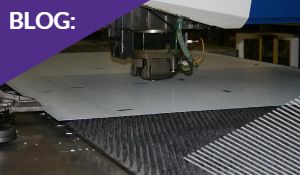How it works: Punch Press

November 23, 2022
Sheet metal fabricators use a wide variety of tools and machines to form materials into various shapes and sizes. Precise and repeat cutting is best achieved using specialist equipment and can include shearing, guillotining, laser cutting, plasma cutting etc. A punch press machine is another excellent option to help to manage the cutting of metal and we take an in depth look at how it works.
What is a punch press machine?
A punch press is a large piece of machinery featuring a hydraulic powered ram at the top. These large machines operated by manufacturers have the capabilities of punching holes at high speed. When the ram is engaged, the metal is compressed against a fixed stationary die, creating a hole in the metal. Punch presses are a great way to cut through these harder materials, ensuring safety throughout the process.
Components of a punch press machine
A punch press consists of many components, some of which include:
- Base/bed - lowest part of the frame, provides support to the workpiece holding the dies and other mechanisms of the press.
- Frame - supports the structure of press. Also supports ram driving mechanisms and controlling mechanism. The frame is divided into two parts, upper part (crown) and lower part (bed).
- Flywheel – the energy storing device of the press. Maintains a constant speed of the ram and avoids fluctuations.
- Brakes - helps to avoid accidents. Machines typically use two brakes, standard (brings driveshaft to rest quickly by disconnecting from flywheel) and emergency (stronger braking power with a power shut switch).
- Bolster plate – a thick plate attached to the base of press to clamp the bottom part of the die.
- Pitman – connects the ram and crankshaft.
- Ram - main operating part of press. The ram moves up and down between guideways with a set stroke length and strength. Can be adjusted for different requirements. The punch is attached to bottom of the ram.
- Driving mechanism - uses a crankshaft to drive the ram, providing power from the motor to the ram.
- Controlling mechanism - used to operate the press under control conditions. Controlling mechanism adjusts the two mechanisms (length of stroke of the ram and power of stroke of the ram). Power transfer can be disengaged using a clutch included in driving systems. Microprocessors used to guide operation of machines. Gives reliable and accurate control with automation.
Types of punch press machines
There are several types of punch press machines used in production, all with different specifications, these include:
Flywheel drive
Most punch presses are now hydraulically powered for convenience, but previously, a constantly rotating flywheel would provide power to the ram. Using a 'pitman' arm, the flywheel drives the ram. Historically, flywheels were driven by a leather drive belt which was attached to the line shafting.
Mechanical drive
This is a common type of punch press used by technicians in the assembly process. There are two types of mechanical punch presses, which are based on their clutch or braking system. Older presses use a full revolution press (open clutch) that requires a complete revolution of the crankshaft to stop the process which can be very hazardous without stringent safety protocols in place. Many countries have strict health and safety requirements for the operation of such machines.
Partial revolution presses however, can pause the ram at any point in it’s rotation creating a higher standard of safety.
Hydraulic drive
These presses use a hydraulic cylinder to power the ram. As these are operated by valves, the ram will move up and down when controlled.
A controlled system is used to enhance the punching rate and can also provide higher control on the ram.
Servo drive
With this press system, the original brake and clutch is combined with the hydraulic ram system. There is a much lower maintenance cost as it doesn't have hydraulics or a chiller (oil-cooling).
The working principles of a punch press
Many industries manufacture products across a variety of projects, using this efficient machinery, so how do they work? Similar to a regular hole punch used on paper, punch presses work in the exact same way, driving a shape downwards into the material to make a clean cut by applying pressure to the die which is attached to the press.
This process consists of two components, the punch and the die. The punch is attached to the ram of the machine and the die is clamped onto a bed/anvil where the flat surface is perpendicular to the pathway of the ram, resulting in the creation of a hole.
Punch presses are usually driven by electric motors where the power demands are intermittent. A flywheel is attached to the drive shaft, storing energy when the machine is idle in between cuts and delivering it to the shaft during punching.
Advantages of a punch press machine
An advantage of this machinery is that it provides highly precise cutting. All the components help to stabilise the work and allow the material to be handled carefully.
The operation itself is reliable and breaking systems ensure the upmost safety for operators.
They are highly productive working with accuracy and repetitiveness around the clock. By reducing reliance on manual labour they are efficient in both work and costs. As technology advances, the machines that have a fully automated process, help to reduce costs and increase value and efficiency.
Discover high-quality metal cutting services
If you are looking to start a new metal cutting project, then Dudley Industries are on hand to help deliver a high quality finished product. With over 80 years experience, we guarantee to provide quality manufacturing expertise. Find out more about our Contract Manufacturing services and metal cutting facilities on our page. Contact us now and find out more information and see how we could make a great contract manufacturing partner for you.